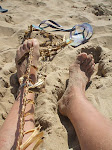 Hek Khaleeli, a friend and much valued patron, sent me a link to a BBC news item about Nick a 67 year old man who has been living on Chiswick Eyot for the past 6 months and it has spurred me to write about this very special place.
Hek Khaleeli, a friend and much valued patron, sent me a link to a BBC news item about Nick a 67 year old man who has been living on Chiswick Eyot for the past 6 months and it has spurred me to write about this very special place.
I first learnt about the Eyot from Tony Kirkham in 2002. At the time he was responsible for the Arboretum and Horticultural Services at the Royal Botanic Gardens, Kew and he had just agreed to let me plant my grown home experiments in the nursery there. I needed to get hold of willows for the experiments but, buying them was not an option because, I wanted them to be local and readily available in order to be true to the philosophy behind grown home. He told me about this little island in the Thames covered in pollarded willows that he thought used to be cut by basket makers. It sounded incredible to me as I had lived in London for 28 years, making baskets for much of that time, yet knew nothing about it.

My first visit to the Eyot in March 2002 was in the company of Diana Hutchings who at the time was a volunteer at Kew and had been instrumental in helping me make contact with Tony. She also knew about the Eyot and kindly offered to show me where it was and to help cut some willows. Hidden behind the Fullers Brewery just off the thunderous A4 was a piece of basket making history that seemed poignantly beautiful to me in the mix of sunshine and snow that we had on that day.
I had been researching the history of willow cultivation in London for my thesis and had found very few records of osier holts anywhere in the greater London area. I was convinced that there must have been many small plots of land used for cultivating willows for baskets around the edges of the city but could find very few references to any. Those I had found were either of nurseries or plantsmen in Chelsea and Hackney who sold willows for cultivation or of its natural occurrence documented in studies of the Flora of London and its counties. But here in all its wintery beauty was the evidence that, at some time in the not too distant past, basket makers had cultivated these osiers.
The Eyot is a tiny island that is covered with water twice a day at high tides but that you can easily walk to at low tide. The Thames rips in and out of there very fast so you have to be acutely aware of the state of the tide when you visit . Diana (pictured here) had found out the time of low water and we squelched across the mud and climbed the bank. The soggy ground was a jetsom lovers paradise, thick with the detritus that is thrown or blown into the river and growing majestically out of this mattress of refuse were the pollards. We spent the next couple of hours cutting common osier rods in the sunshine keeping a wary eye on the rising tide.
 Subsequent research revealed that the Eyot had been planted and cultivated for basket making between about 1800 and 1935 when the last person granted a right to cut the osiers went out of business and the island was subsequently taken over by the local council. The demand for baskets in the area had come from the numerous market gardens in the area that needed containers to transport their produce downstream to the markets of the city of
Subsequent research revealed that the Eyot had been planted and cultivated for basket making between about 1800 and 1935 when the last person granted a right to cut the osiers went out of business and the island was subsequently taken over by the local council. The demand for baskets in the area had come from the numerous market gardens in the area that needed containers to transport their produce downstream to the markets of the city of
London.

Since 1949 the willows have been managed by the Old Chiswick Preservation Society in order to prevent further erosion of the island. Another incentive for the locals to cut the osiers, however, is that they block the grandstand view from the houses on Chiswick Mall of the Oxford and Cambridge boat race. It seemed too strange a coincidence to discover that one of these handsome houses overlooking the Eyot is called Walpole House!
There is a good account of the history of the Eyot in the following publication for anyone interested in doing more research.
Pape, David, Nature Conservation in Hounslow Ecology Handbook 15, London Ecology Unit 1990, ISBN 1-871045-11-8
This is the BBC clip which shows the island and Nick constructing a shelter for himself from the osiers.



No comments:
Post a Comment